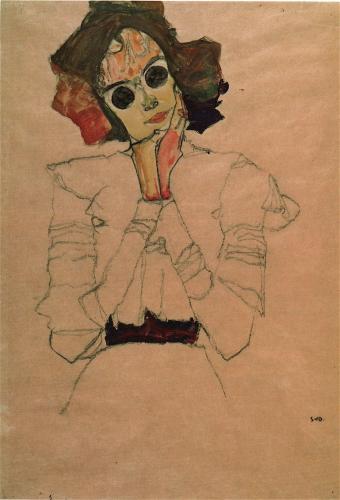-
-
Par MMaxi le 22 March 2007 à 12:36

The painter Max Oppenheimer, three-quarter Length, 1910 by Egon Schiele
Max Oppenheimer, a native of Vienna, began to study art at the Academy at the age of fifteen, continuing from 1903 at the Prague Art Academy. In 1906 Max Oppenheimer joined the Prague group 'OSMA' (the Eight), one of the first associations of Czech avant-garde artists. At the time Oppenheimer's style revealed a growing interest in Impressionist painting, especially that of Max Liebermann. In 1908 Max Oppenheimer moved back to Vienna, joining the circle of Oskar Kokoschka and Egon Schiele. His encounter with Kokoschka's painting exerted a formative influence on Oppenheimer, especially in the field of the psychological portrait. After participating in several group shows, Oppenheimer had his first one-man show at the Moderne Galerie in Munich in 1911. That same year Oppenheimer began to work on the journal 'Die Aktion', founded by Franz Pfemfert in Berlin. In 1915 Oppenheimer moved to Switzerland, where he would remain, with interruptions, until 1924. His style of painting subsequently incorporated Cubist elements that would become characteristic of his work. Introduced to Dada in 1916, Oppenheimer participated in the first Dada exhibition in Zurich that year. Oppenheimer embarked on his celebrated orchestra scenes, which were shown in 1924 at a large-scale group exhibition mounted by the Vienna Haagebund. Oppenheimer went to Berlin again in 1926 but by 1931 the political situation in Germany was so fraught [sic!] that he decided to return to Vienna. A year later his work was confiscated during the widespread wave of persecution of Jews and SA defamation of their work that followed the Reichstag fire. In 1932 Oppenheimer participated a last time in a group show at the Vienna Künstlerhaus before fleeing to Switzerland in 1938. In 1939 Oppenheimer emigrated to the US, where his work revealed a reversion to earlier ideas. Shortly before his death in his New York apartment on 19 May 1954, Max Oppenheimer was experimenting with American Abstract Expressionism.
-
Par MMaxi le 22 March 2007 à 12:24

Egon Schiele
Girl with sun glasses ( Gertrude Schiele ), 1910 Albertina, Vienna
Isolated patches of relatively unmodulated color, on the sunglasses and belt, are played against more expressively nuance flesh tones.
The balancing of these two different approaches, like the balancing of painted and unpainted areas, is a legacy of Schiele's Jugendstil background.
-
-
Par MMaxi le 21 March 2007 à 11:43

Check Vincent Van Gogh's thème, Arles Bedroom, 1888 blogg posting on the 04/07/2006
A version of Van Gogh's painting was owened by Schiele's patron Carl Reininghaus and
Exhibited at the 1909 "kunstschau"
MMaxi
-
Par MMaxi le 17 March 2007 à 23:41

Sunflower II, 1909 Wien museum, Vienna
Vincent Van Gogh has always been well
known for his sunflower paintings,
examples of wich were exhibeted
at the Vienna Secession in 1903 and
again at the GalerieMiethkein1906. Many
Viennese artists, including not just
Schiele but also Klimt, were inspired by
Van Gogh to paint sunflowers.
-
-
-
Par MMaxi le 17 March 2007 à 23:11

Nude Girl with folded arms ( Gertrude Schiele ). 1910 Albertina Vienna
Like Minne's nude boy. Schiele's sister clasps her arms tightly across her chest,
modestly protecting her naked torso even as she exposes her genitalia to public scrutiny.
For both artist's, as for Kokoschka, the adolescent body was a perfect vessel for sexual ambivalence.
-
Par MMaxi le 17 March 2007 à 23:04

Man with a blue headband and hand on cheek ( self portrait ) 1909, Albertina. Vienna
Although a residue of jugendstil stylization remains in the decorative headband and the
patterns on the artist's Tshirt, Expressionist elements emerge in the contorted face and hand.
The switch from colored pencil to water colour in early 1910 would allowSchiele to
capitalize on these Expressionistic tendencies.
 Follow this section's article RSS flux
Follow this section's article RSS flux
MMaxi Madeiraman








